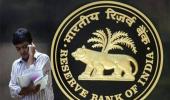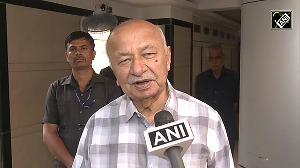The average time lag between the date of occurrence of a fraud and its detection is 23 months; for large frauds (Rs 100 crore and above), it was 57 months.

The Supreme Court's verdict that borrowers must be heard before an account is classified as fraud is a big relief for India Inc.
Though it places the onus on banks before they proceed down this line, the spotlight is firmly on an issue that doesn't get the attention it deserves: the frauds chain, from detection to redress.
The Reserve Bank of India's annual report for 2020-2021 noted that the average time lag between the date of occurrence of a fraud and its detection is 23 months; for large frauds (Rs 100 crore [Rs 1 billion] and above), it was 57 months.
A two-decadal analysis by the Financial Stability Report of June 2019 (FSR: June 2019) found that frauds between FY01 and FY18 constituted 90.6 per cent of what was reported in FY19 by value.
This is surprising given that banks had migrated to 'live reporting' through Fraud Monitoring Returns from April 1, 2017. But frauds continue to plague the system.
In September 2019, RBI Deputy Governor M K Jain observed that 'some of the weaknesses and irregularities observed have been recurring in spite of the averments made by bank managements (about) having carried out remediation.'
And 'it will not be an exaggeration to say that some of the big losses suffered by banks on account of frauds could have been avoided if a good compliance culture was ingrained in the respective banks.'
In the FSR: June 2019, the RBI said as of December-end 2018, 204 borrowers who had been reported as fraudulent by one or more banks were not classified as such by others having exposure to the same borrower.
One of the major areas of non-uniformity in processes pertains to identifying red-flagged accounts (RFA) based on an indicative list of early warning signals, which is not uniform across banks.
In several cases, banks were unable to confirm RFA-tagged accounts as frauds or otherwise within the prescribed period of six months.
And data from the Central Repository of Information on Large Credits (which warehouses data on all borrowers' credit exposures) for FY19, had it that RFA reported by banks exceeded the stipulated six-month period in 176 cases.
The reasons cited included delays in either completing, or inconclusive findings of forensic audits.
If this was not bad enough, the ecosystem grinds to a near halt after having sniffed a fraud, and seldom takes the next remedial steps.
A classic case is that of ABG Shipyard -- the ICICI Bank-led consortium declared its Rs 14,000 crore (Rs 140 billion) exposure to the company as a fraud in 2019, which was first reported by Business Standard on January 24, 2020.
Yet, it was only in February 2022 that the Central Bureau of Investigation filed its First Information Report -- when the exposure was closer to Rs 25,000 crore (Rs 250 billion) due to the compounding of interest -- making it the biggest banking fraud till date.
Here again, it must be reiterated that the whole exposure is not to be seen as a fraud. Could it also be that the way fraud numbers are reported is flawed?
Senior bankers point out that it would be appropriate to consider the "amount at risk" as the fraud and not the total outstanding -- the exposure on the borrower.
The "amount at risk" may be arrived at by the bank assessing the amount and probability of "risk materialising".
And it may be validated by an independent assessor, such as statutory, or a reputed forensic auditor.
In the current RBI prescription, the fraud amount -- as it gets reported -- becomes inappropriately high.
For instance, if a consortium of banks has extended, say, Rs 5,000 crore (Rs 50 billion) to a borrower, the entire amount is deemed a fraud even if it's a Rs 100 crore (Rs 1 billion) transgression within a bank.
The RBI's diktat that all banks in a consortium classify the exposure as a fraud -- even if the incidence is only restricted to a bank or two -- may even have acted as a perverse incentive: for not declaring frauds.
This is because it would mean having to inform the consortium, and all banks will have to hang together due to the RBI's diktat on uniformity in fraud classification.
That is, declare it as a non-performing account (even if current) and make provisions.
In the case of State-run banks, which had been dependent on recapitalisation support from the Centre, it made eminent sense to push matters under the carpet.
And while you have data on bank frauds, there's nothing in the books of non-banking financial companies (NBFCs).
This, when two NBFCs turned out to be fraudulent entities: The Infrastructure Leasing & Financial Services; and Dewan Housing Finance Corporation.
This is a blind spot -- NBFCs are interconnected with other entities in the financial sector; and are as exposed to similar risks as banks.
Given that stress in a company may also act as a trigger to commit fraud, it is perhaps best to look at other data points: Look at its beneficial owners, bank transfers, salary and creditor payments, and regulatory filings.
At another level, in recent years, fraud detection has emerged as a lucrative business.
In May 2019, over 70 firms queued up to be on the Indian Banks' Association's empanelled list of forensic auditors.
This included Alvarez & Marsal, Kroll, Ernst and Young, BDO India, PwC, BMR Advisors, KPMG and Deloitte; and many home-bred firms that never or rarely make headlines.
It is believed that the annual fee pool for forensics is at around Rs 1,000 crore/Rs 10 billion (it depends on how the business is sliced and diced).
Soon, lawyers will join the party.
'Natural justice' to an aggrieved borrower was the casualty to a large extent because of the short interval available to them to offer relief under the RBI's Master Directions (Frauds-Classification and Reporting) by commercial banks and select Financial Institutions of July 1, 2016 (updated as on July 3).
What if a borrower were to seek remedies citing the Supreme Court order?
With capital quoting at a premium, the system can ill-afford vast sums getting locked in frauds and its provisioning at the expense of shareholders and depositors.
The sub-committee of Financial Stability and Development Council at its meeting on September 27, 2019, chaired by RBI Governor Shaktikanta Das discussed measures to strengthen the system against frauds and revisiting the framework for early warning signals.
And now with the Supreme Court verdict, the banking regulator can be expected to quicken its stride on this front when it issues its revised guidelines on frauds.














 © 2025
© 2025